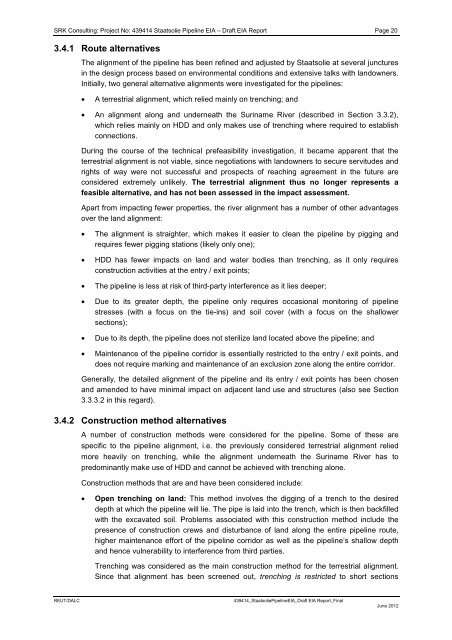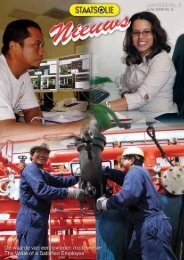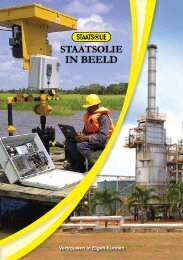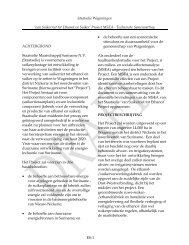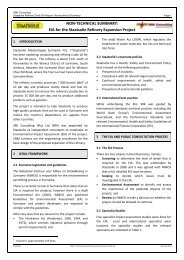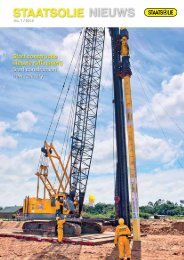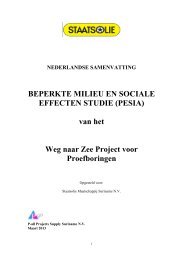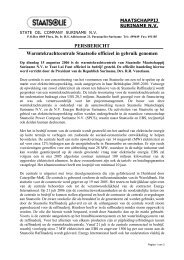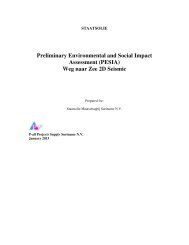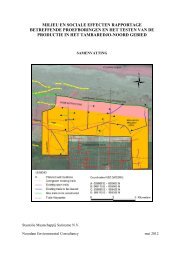concept EIA-rapport - Staatsolie
concept EIA-rapport - Staatsolie
concept EIA-rapport - Staatsolie
Create successful ePaper yourself
Turn your PDF publications into a flip-book with our unique Google optimized e-Paper software.
SRK Consulting: Project No: 439414 <strong>Staatsolie</strong> Pipeline <strong>EIA</strong> – Draft <strong>EIA</strong> Report Page 20<br />
3.4.1 Route alternatives<br />
The alignment of the pipeline has been refined and adjusted by <strong>Staatsolie</strong> at several junctures<br />
in the design process based on environmental conditions and extensive talks with landowners.<br />
Initially, two general alternative alignments were investigated for the pipelines:<br />
• A terrestrial alignment, which relied mainly on trenching; and<br />
• An alignment along and underneath the Suriname River (described in Section 3.3.2),<br />
which relies mainly on HDD and only makes use of trenching where required to establish<br />
connections.<br />
During the course of the technical prefeasibility investigation, it became apparent that the<br />
terrestrial alignment is not viable, since negotiations with landowners to secure servitudes and<br />
rights of way were not successful and prospects of reaching agreement in the future are<br />
considered extremely unlikely. The terrestrial alignment thus no longer represents a<br />
feasible alternative, and has not been assessed in the impact assessment.<br />
Apart from impacting fewer properties, the river alignment has a number of other advantages<br />
over the land alignment:<br />
• The alignment is straighter, which makes it easier to clean the pipeline by pigging and<br />
requires fewer pigging stations (likely only one);<br />
• HDD has fewer impacts on land and water bodies than trenching, as it only requires<br />
construction activities at the entry / exit points;<br />
• The pipeline is less at risk of third-party interference as it lies deeper;<br />
• Due to its greater depth, the pipeline only requires occasional monitoring of pipeline<br />
stresses (with a focus on the tie-ins) and soil cover (with a focus on the shallower<br />
sections);<br />
• Due to its depth, the pipeline does not sterilize land located above the pipeline; and<br />
• Maintenance of the pipeline corridor is essentially restricted to the entry / exit points, and<br />
does not require marking and maintenance of an exclusion zone along the entire corridor.<br />
Generally, the detailed alignment of the pipeline and its entry / exit points has been chosen<br />
and amended to have minimal impact on adjacent land use and structures (also see Section<br />
3.3.3.2 in this regard).<br />
3.4.2 Construction method alternatives<br />
A number of construction methods were considered for the pipeline. Some of these are<br />
specific to the pipeline alignment, i.e. the previously considered terrestrial alignment relied<br />
more heavily on trenching, while the alignment underneath the Suriname River has to<br />
predominantly make use of HDD and cannot be achieved with trenching alone.<br />
Construction methods that are and have been considered include:<br />
• Open trenching on land: This method involves the digging of a trench to the desired<br />
depth at which the pipeline will lie. The pipe is laid into the trench, which is then backfilled<br />
with the excavated soil. Problems associated with this construction method include the<br />
presence of construction crews and disturbance of land along the entire pipeline route,<br />
higher maintenance effort of the pipeline corridor as well as the pipeline’s shallow depth<br />
and hence vulnerability to interference from third parties.<br />
Trenching was considered as the main construction method for the terrestrial alignment.<br />
Since that alignment has been screened out, trenching is restricted to short sections<br />
REUT/DALC 439414_<strong>Staatsolie</strong>Pipeline<strong>EIA</strong>_Draft <strong>EIA</strong> Report_Final<br />
June 2012


